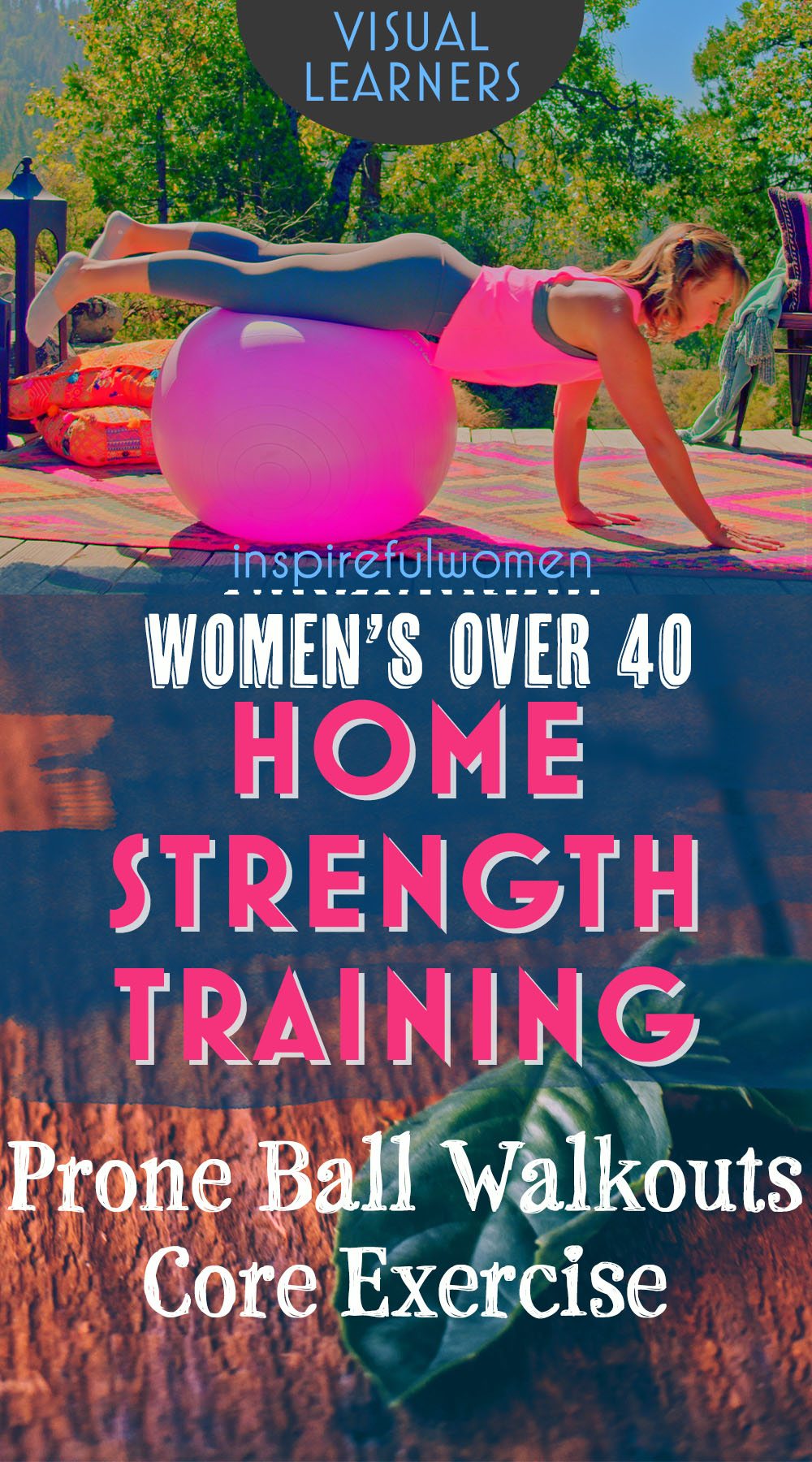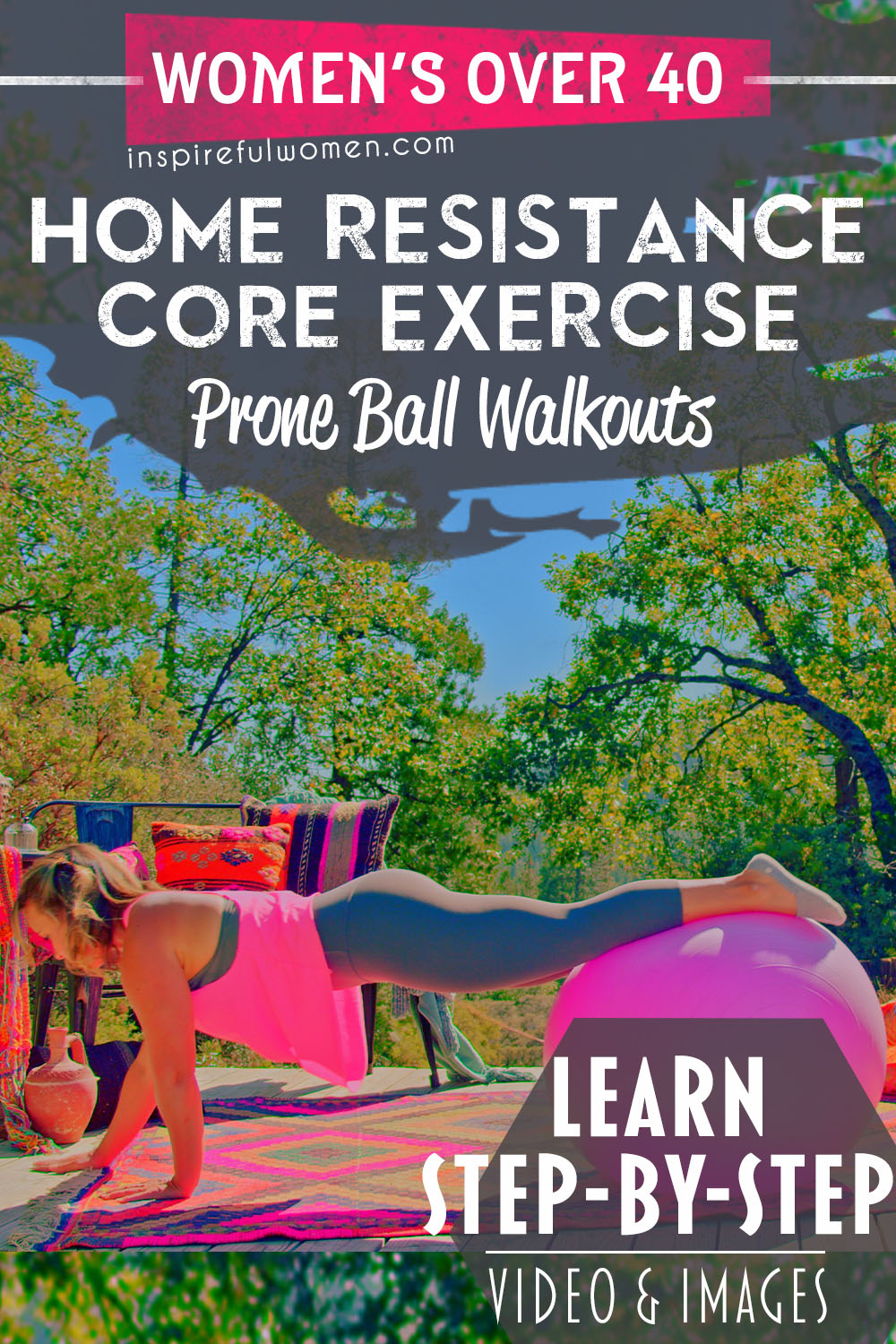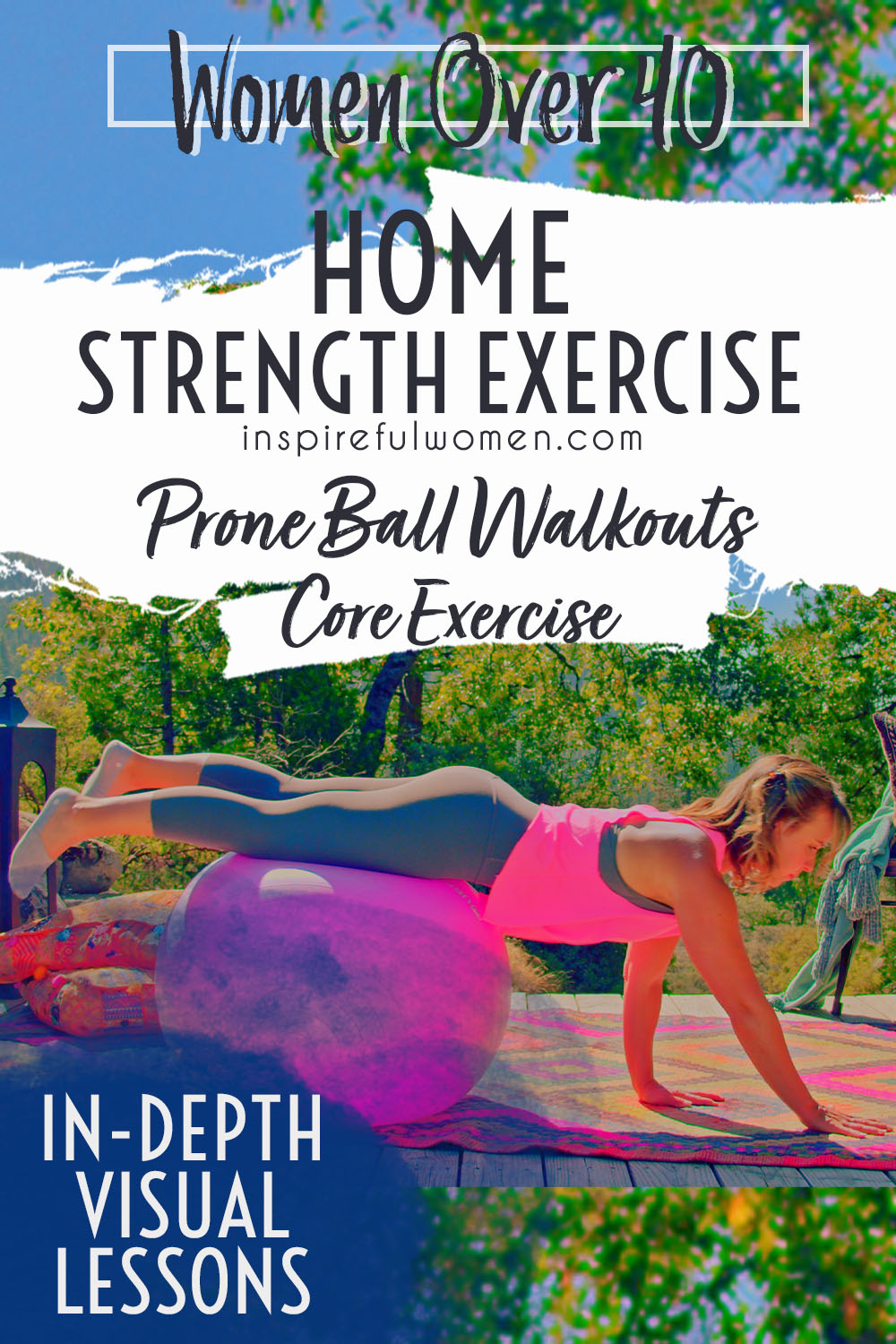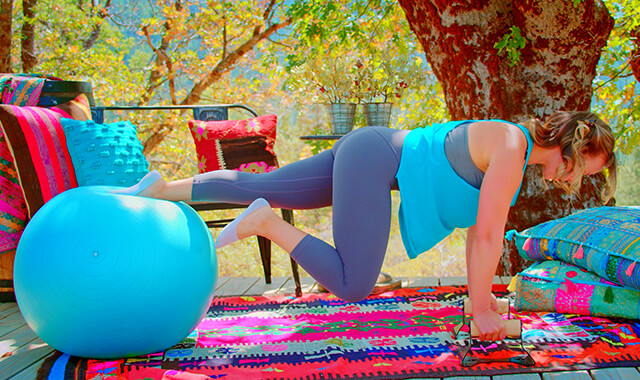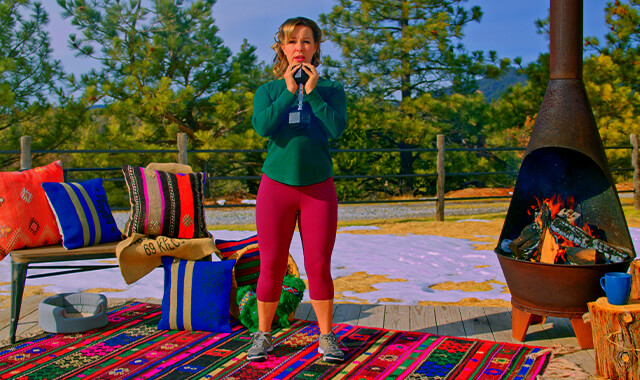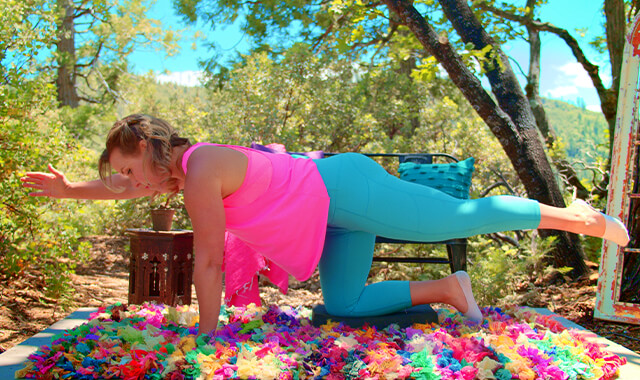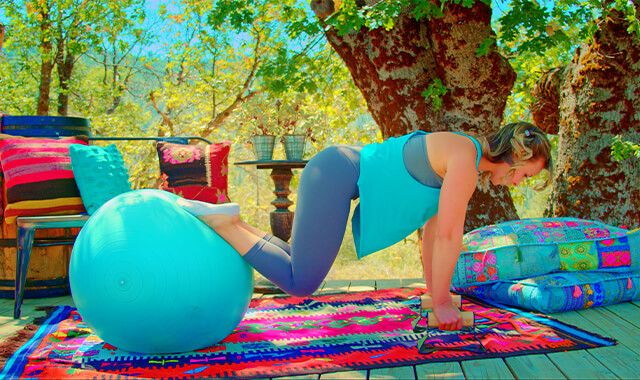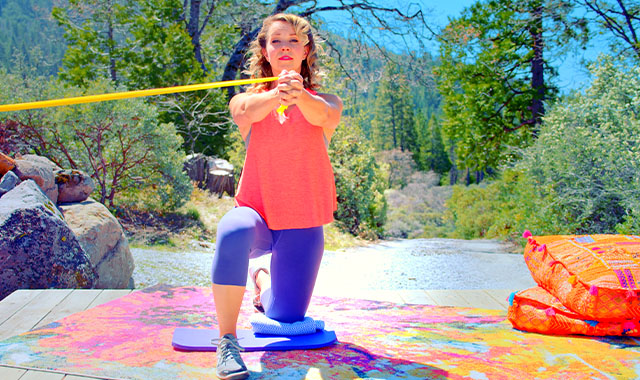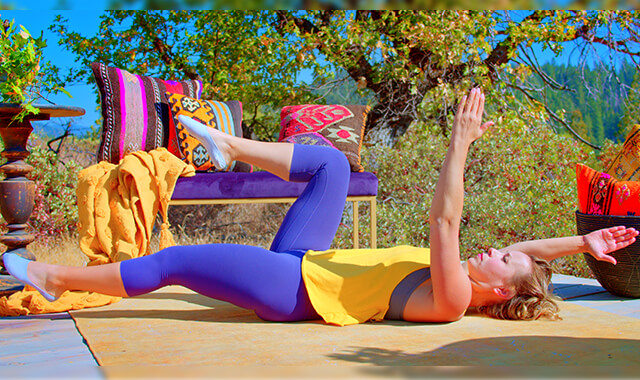Prone Stability Ball Walkouts
How to Do the Beginner Prone Stability Ball Walkout - Core/Ab Exercise | In-Depth Guide [VISUAL LEARNERS] Beginner
Proper Form & Common Mistakes | Home Resistance Training
WHAT DO YOU WANT TO SEE?
QUICK DEMO
QUICK DEMO
MUSCLES THIS WORKS
MUSCLES
MAIN MUSCLES WORKED IN the Prone Stability Ball Walkout
Lots of core Muscle - See below
Erector spinae (semispinalis, rotators, interspinalis and intertransversarii), multifidi, obliques, quadratus lumborum, rectus abdominis, transverse abdominis, and iliopsoas
OTHER MUSCLES WORKED:
- Lats
- Gluteus maximus
WHAT WE'RE DOING TODAY
WHAT & WHY
BENEFITS OF TRAINING THE Core
WHAT
WHAT WE'RE DOING TODAY
Other names for this exercise: Stability Ball Core/Ab Exercise or Swiss Ball Core/Ab Exercise
ALL WE'RE DOING:
With your body on the ball, walk out with your hands.
TRAINING CORE STABILITY & STRENGTH
The stability ball core exercises work the entire body from head to toe. Not only can they be used for strengthening muscles, they are really good for training the muscles to hold the body in a healthy position, with stability and balance. The great thing about the stability ball exercises, other than that they are a lot of fun, is that they are easy to adjust for the beginner and progress for the very advanced exerciser. Over time, as you improve, more of your body weight is shifted from the ball to the arms.
MIND-BODY CONNECTION
The other interesting thing about working on a ball is that it is really training your mind-body connections. If you have never worked on a stability ball before, you might find that just trying to stay on the ball can be pretty challenging. But after just one or two times, it is amazing how comfortable you will be. Training balance and core stability is more about teaching your body what to do and less about strengthening the muscles. The core muscles are not big strong muscles. They are not power muscles like the big muscles of the legs and arms. Their job is more about knowing when to work and how much to work in order to hold you still. Core exercises are about training your muscles to work the right way. Most people’s core muscles are strong enough to do their job, they just don’t know how to do it.
STRENGTH IS MORE THAN JUST SIZE
There are two ways that we gain “strength”: 1) more muscle fibers working, and 2) growing the size of the muscle fibers. The stability ball core exercises are a good example of exercises that call in more muscle fibers to work - the brain “recruits” more of the muscle to wake up and help. This is a brain-body thing, the muscles are there, they just are not active. The great thing is that it only takes a few sessions to train these muscles to help out. So the improvements in stability and balance can happen pretty quickly. This is different from exercises that make the muscle fibers get bigger - this takes time, you have to work the muscles 2-3 times per week for 4 to 6 weeks before you will notice a difference.
WHY BOTHER DOING IT?
WHY
WHY DO WE EVEN CARE?
THE FOUNDATION THAT ALL OUR BODY MOVEMENT USES
The main job of the trunk muscles is to hold the torso upright and to provide a stable base for the arms and legs to work off of. Too much movement in the spine can lead to injury or damage to the joints of the spine or the nerves that exit between the vertebrae. Just to be clear - the spine needs to be able and allowed to move - walking around with a stiff posture is not good either. Our joints get nourishment from movement and also get rid of waste through movement. The goal is to have a flexible spine that is able to move freely when needed - like a tree trunk in a high wind - the trunk needs to be able to move with the breeze, if it were rigid it would crack. But, bending the trunk over and over and over, especially if the branches were heavy with ice or fruit - would lead to breaking. This is a good way to think about your spine - it should not be stiff but when you exercise it, it is best to do exercises that strengthen the muscles to help support the spine, not bend it at one place over and over again, and especially not when loaded (ie -holding a weight).
The spine is not straight but has natural curves. The curves are specifically designed to increase the spine’s strength, flexibility, and ability to absorb shock. The healthiest position for the spine is a neutral position - not bent forward, backward, to the sides, or rotated. In this position, the joints and nerves are not being stretched or compressed. This is the safest position to train the core muscles to do their job.
The joints of the spine are tiny and are stabilized by many layers of tough ligaments. This is very different from the shoulder and hip joints, which are large ball and socket joints - they have more motion and less stability than any other joints in the body. From this, it is easy to understand that the spine is the pillar of support for the shoulders and hips to move off. The safest way to train the muscles is to train them to hold the spine still as the arms and legs move.
EVERYDAY LIFE
EVERYDAY LIFE &
MUSCLE FUNCTION
HOW WE USE OUR core IN EVERYDAY LIFE
ALL OF THE MUSCLES OF THE CORE WORK TOGETHER TO STABILIZE THE SPINE.
1. HOLDING THE BODY UP:
- Standing
- Walking
- Running
- Squatting
- Sitting
2. HOLDING THE SPINE IN GOOD ALIGNMENT DURING:
- Removing clothes from washer/dryer/dishwasher
- Lifting -boxes, kids from the floor, and groceries out of a car
- Pushing a stroller, wheelbarrow
- Carrying - kids, groceries
- Bending forward
- Picking things up from the floor
- Gardening
- Shoveling, raking, sweeping, vacuuming
- Leaning backward - replacing an overhead light bulb, lifting dishes up or down from a high shelf
STARTING POINTERS
Starting Pointers
Ball walkouts are a great way to work the core muscles. This version of a walkout is done lying over the ball, facing down (prone). This exercise will work the abdominals and back muscles, as well as the muscles of the shoulders and hips. Using a ball is really convenient for making quick adjustments to the exercise to make it easier or harder.
Stability ball walkouts train us how to keep our torsos stable while we are moving through our shoulder joints. The body is held in a position parallel to the floor. In this position, it is easy to feel all of the muscles of the core, hips, and shoulders involved in holding up us against the downward pull of gravity. The spine is held in a neutral position - no flexion, extension, side bending, or rotating - from the cervical spine down to the tailbone.
HOW TO DO THE EXERCISE
LOOKS
HOW Prone Stability Ball Walkout SHAPE OUR BODY
Flat stomach and toned waist. Upright posture, strong, graceful movement - having a strong core makes it easier to move the arms and the legs with control and power.
PROPER FORM
PROPER FORM: Prone Stability Ball Walkout
EQUIPMENT, SETS & REPS
EQUIPMENT
STABILITY BALL
Tip: It's best to get one that has a slightly textured feel to it, like the pearlescent ones. If they don't have a textured surface, the ball tends to be slippery on the surface (carpet, floor, whatever) and it can come out from under you pretty easily (ask me how I know).
Here are my recommendations that have a textured surface:
One size, many color options. I have one of these at home and it doesn't slip.
Galsports has different size options for the ball which is nice if you are fairly tall or fairly short. Your height will change what size ball will be the best for you. I have one of these in the Large size, which is about the "standard" ball size, and it works well. The small size is too small for our purposes no matter your height.
SUGGESTED STARTING WEIGHT FOR WOMEN:
Bodyweight
SETS & REPS:
8 - 10 reps
PACE:
Slow control, focus on form not speed or number of reps. Hold 5-10 seconds at the end of the walkout. The muscles are being worked for endurance: low level for a longer duration.
BODY POSITION
BODY POSITION FOR THE Prone Stability Ball Walkout
NOTES: The size of your ball & how full of air it is, I personally find to play a big role in how able I am (or not!) to do this movement.
FULLNESS: The more full your ball is the less stable/more squirrely it will feel. For me, a ball that has a bit of squish to it works best.
SIZE: The larger the ball is, depending on your height, if this shifts your body so that you are not parallel to the ground but rather your backside is more tipped in the air, this will put quite a bit more weight on your shoulders which will make it a LOT more challenging to lift your hands and keep yourself stable. I find having a smaller ball where my body is either parallel to the ground from head to toe or even where my body angles down the opposite way- highest from the head and angling in a small diagonal line to my feet, makes it easier to do the movement.
I wasn’t able to even do this movement until I made these 2 changes. Not overly full ball + ball size to make your body no more than parallel to the ground- feet shouldn’t be higher than your head/shoulders when looking from the side.
----------------------------------------
Place the stability ball on the floor and kneel behind it. Lean over and place your hands and chest on the ball. Push yourself forward with your feet. Keep rolling the ball forward until your hands are on the floor. Depending on the size of the ball your feet may lift up off of the floor when your hands are on the floor.
BODY STANCE: Belly and hips on the ball. Neutral spine (includes cervical). Shoulder blades down and in, sternum lifted.
ARMS: Shoulders at 90 degrees of flexion - keep the space between your earlobe and the top of your shoulder. Arms straight, your elbows soft.
HANDS: Hands directly under shoulders, shoulder width apart. Palms on the floor, fingers facing forward
LEGS: Depends on the size of the ball - your toes may be on the floor but they may lift off when your hands get to the floor. Legs are together, straight, energized.
HOW TO DO
HOW TO DO the Prone Stability Ball Walkout
CUE: The goal is to be as controlled and stable as possible, even if it means limiting how far you walk out.
Lengthen your spine - imagine reaching out through the top of your head and through your feet.
Gently engage your abdominals, if you can also activate your pelvic floor muscles it will help stabilize your spine.
With slow control, use your hands to walk forward, your body will move forward on the ball. As you walk out your core will have to work harder to keep your torso still.
Your torso should be level - imagine having a cup of tea on your low back and not letting it spill as you walkout.
You will need to increase the amount of body weight in your hand that is staying on the floor in order to lift your other hand to walk forward. It may help to just try holding your position and unweighting your hand before lifting. Lifting your arm to walk forward or backward should not cause your torso to rotate - your shoulders and hips should remain squared to the floor. If you are unable to keep the torso squared (not lifting one side to move your hand) then that would be your stopping point. You can work on just lifting one arm and then your other arm without adding movement. You will be holding all of your upper body weight on one arm when you lift your other arm - this should be done with control, not quickly lifting up and then dropping your arm back down.
Only walk out as far as you are able to maintain control. Stop at the point where you are just able to keep your body still and your spine in neutral.
Feel one line of energy from the top of your head to the toes. This will help activate your core. Your body should be in one straight line - earlobe - shoulder- hip - knees - ankles, and parallel to the floor. Your hands should be right under your shoulders.
Hold for 5-10 seconds.
Maintain stability and control as you slowly walk back to the starting position.
Repeat for the desired number of reps.
HOW TO SAFELY GET OUT OF THE EXERCISE
Walk your hands back until your feet touch the floor. Continue to push the ball forward under you until your knees are on the floor. Push up to standing.
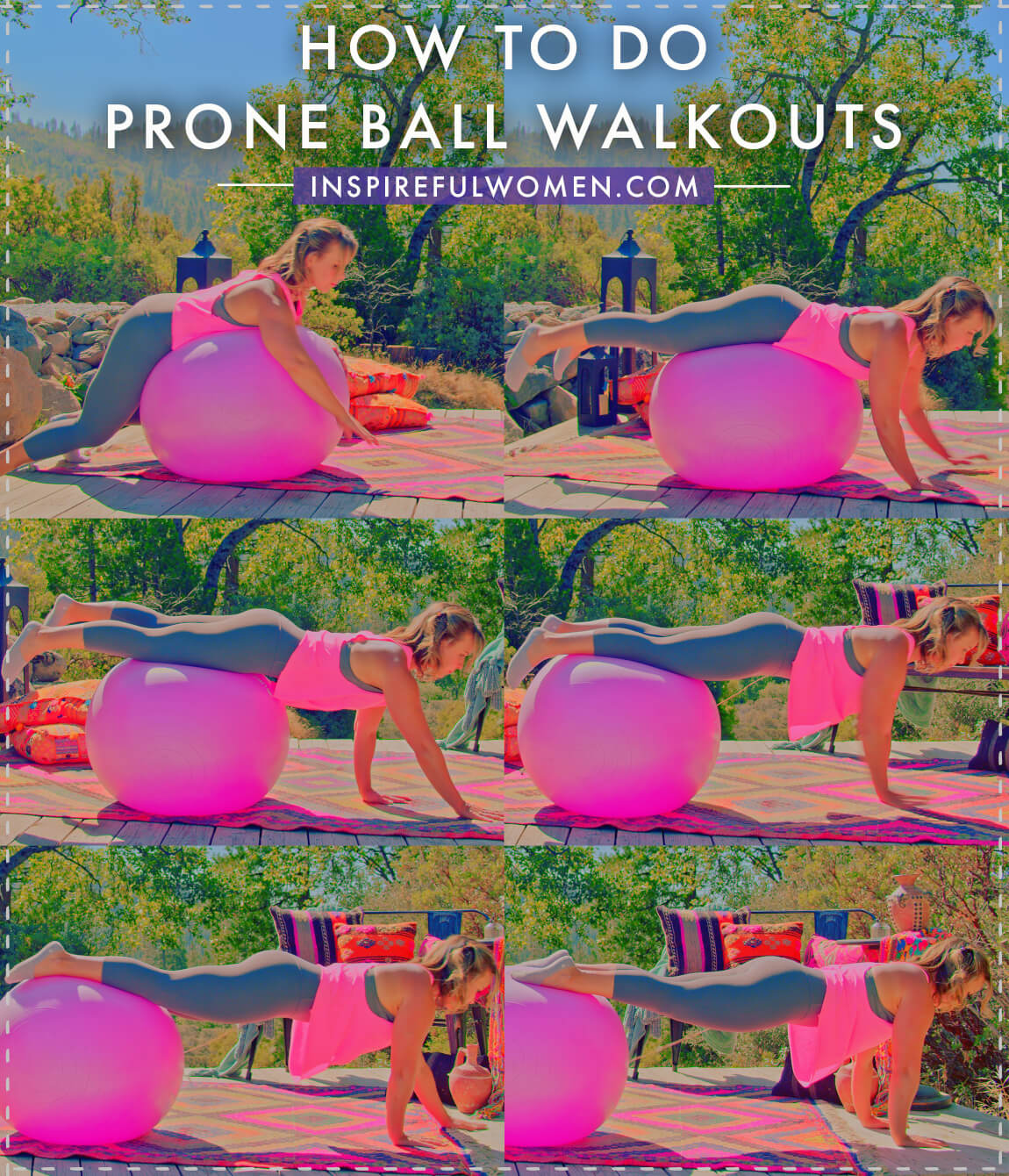
COMMON MISTAKES
COMMON MISTAKES
WHAT TO AVOID WITH THe Prone Stability Ball Walkout
KEY TIP:
Guess what? Good news! Many avoids are the same for most movements. Once you learn the basics, there's really only a few extra avoids for each individual movement.
1. Avoid Low Back Sag
AVOID: Avoid letting the low back sag.
WHY NOT?
- Too much extension in the low back can strain the muscles and ligaments of the spine.
The back can sag if you collapse in the shoulders or upper back.
WHAT TO DO:
- Maintain a neutral and stable spine.
- Activate the abdominal muscles - the rectus abdominis will work to prevent spinal extension.
- Push down into the floor with your hands, pull your shoulder blades in and down the back and lift the sternum.
- Try engaging the pelvic floor.
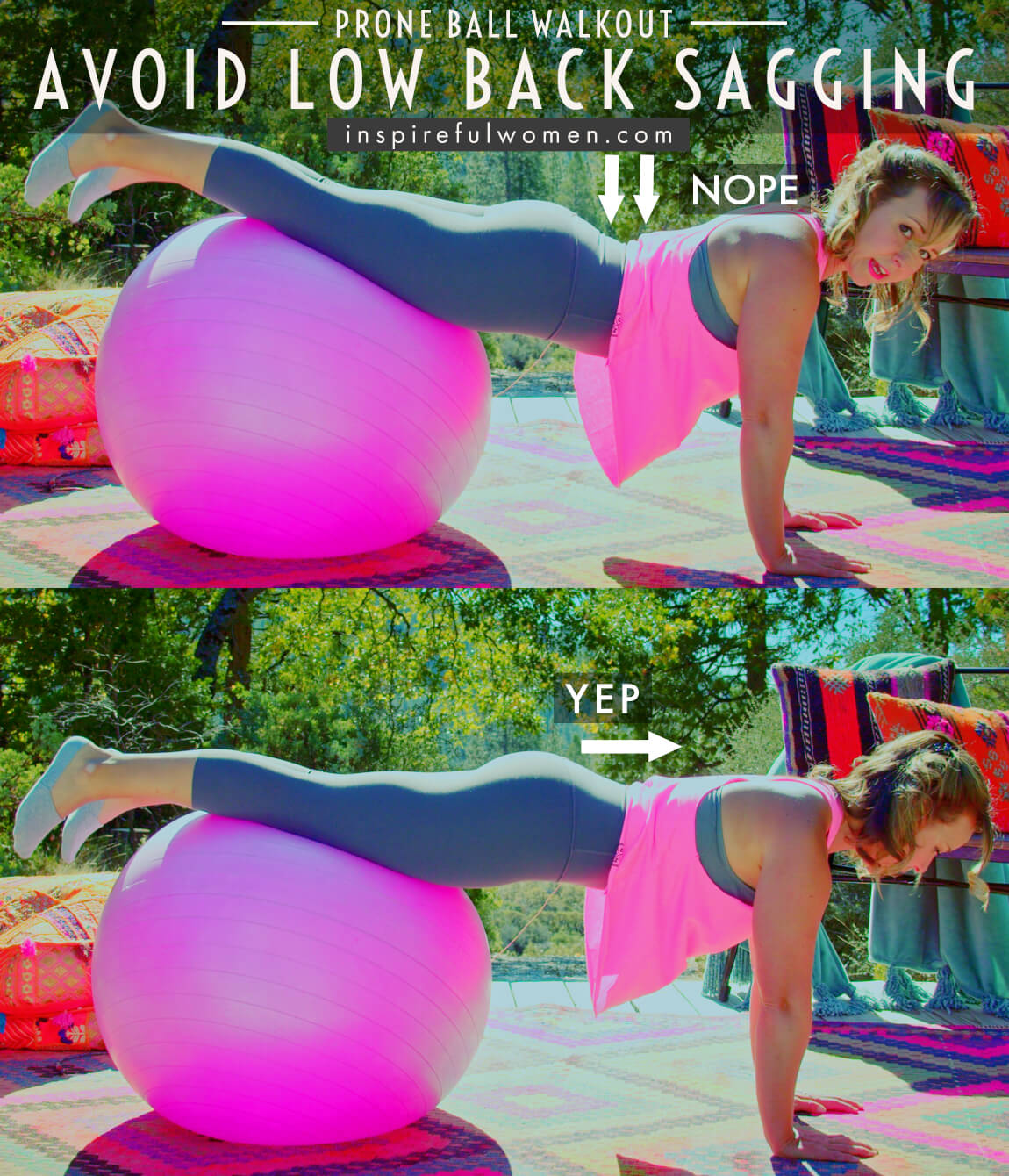
2. Avoid Rounding Spine
AVOID: Avoid rounding the back.
WHY NOT?
- Too much flexion in the spine can lead to irritation or compression of the spinal joints and discs.
WHAT TO DO:
- LIft the sternum, push your upper body up and lower your pelvis (hip in line with shoulder and knee).
- Lengthen the spine.
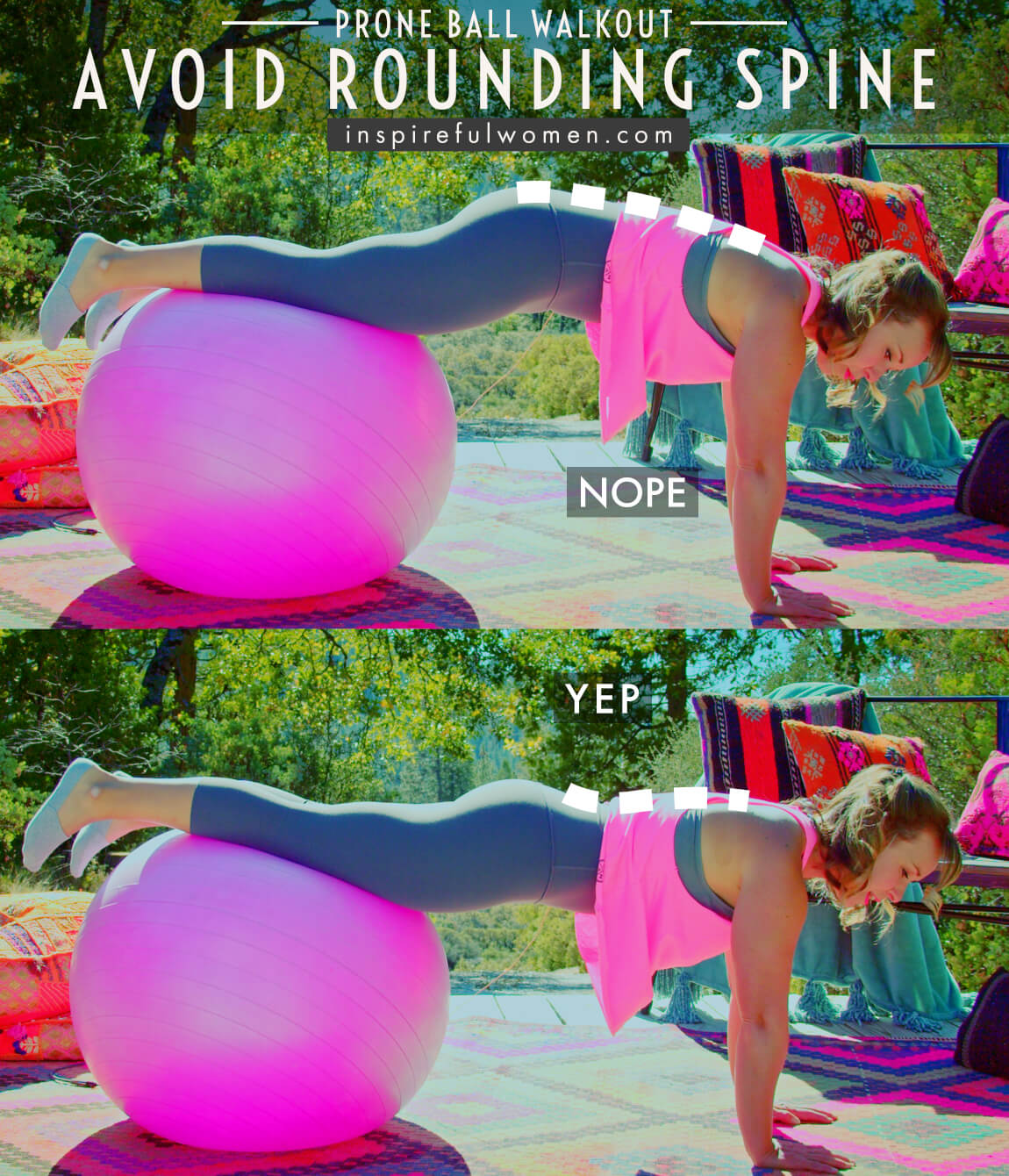
3. Avoid Lifting Hips
AVOID: Avoid lifting your hips.
WHY NOT?
- Lifting the hips up is a common cheat that decreases the muscle activation of the core and the hips.
- Lifting the hips results in an angle or v shape - the hip joint is higher than the shoulder and higher than the knee.
- This will decrease the effectiveness of the exercise - hip flexors more active and spinal stabilizers less active.
WHAT TO DO:
- It is important not to hold the hips in a flexed position.
- The goal is to make your body a straight line - earlobe, shoulder, hip, knee, ankle.
- Lower your pelvis down and activate your core muscles.
- Keep the front of the hip flat - no crease.

4. Avoid Lifting Neck
AVOID: Avoid lifting the chin.
WHY NOT:
- It is easy to lift your head to see where you are going.
- This can lead to neck strain and damage to the soft tissue and small joints of the cervical spine (neck).
WHAT TO DO:
- Keeping your neck (cervical spine) in neutral will strengthen the muscle of the neck in a neutral position - the healthiest position for the joints and nerves (part of a neutral spine position).
- Keep your neck long and look down at the floor.
- Keep space between your earlobe and the top of your shoulder.
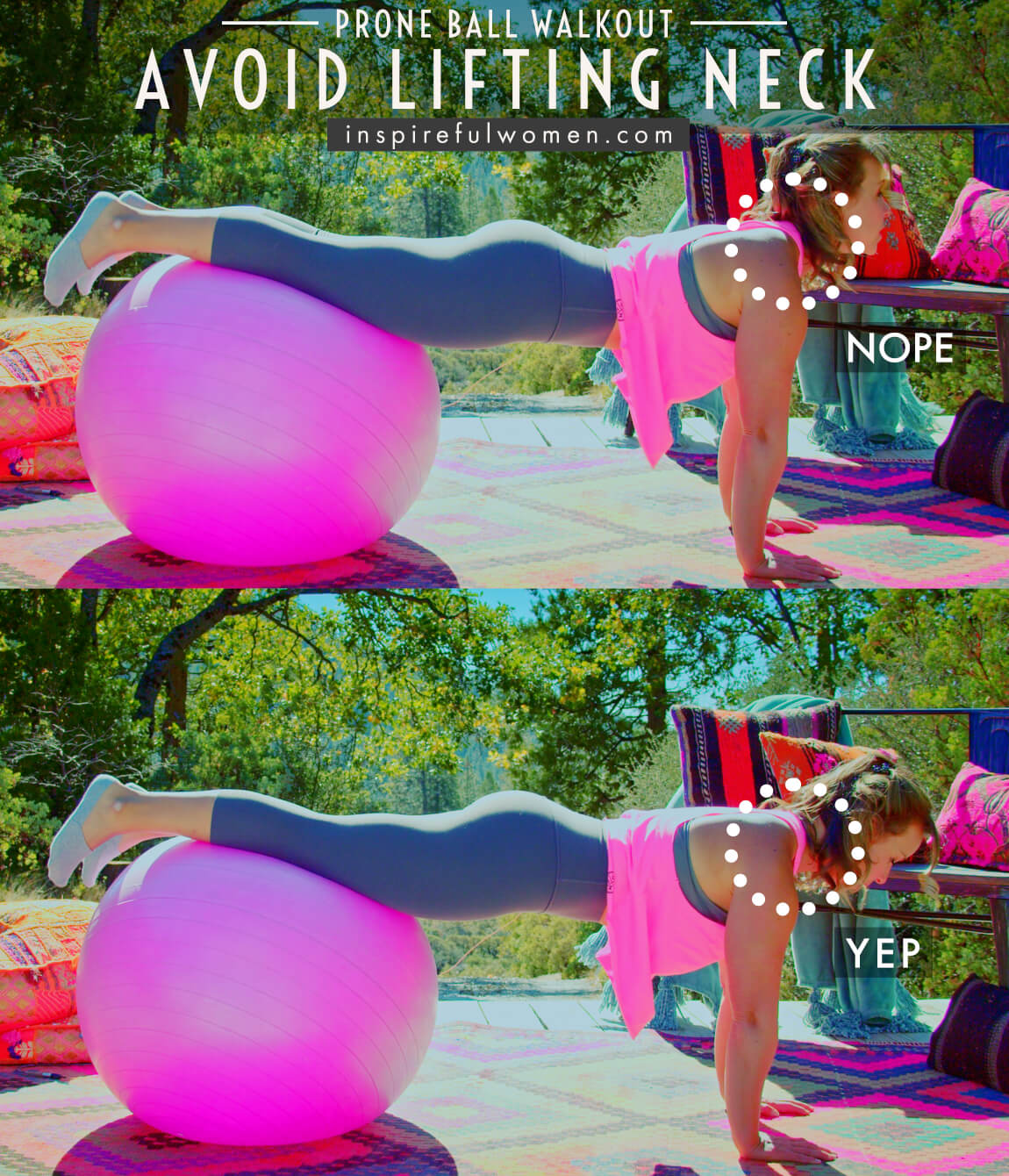
5. Avoid Locking Elbow Joints
AVOID: Avoid locking or hyperextending your elbows.
WHY NOT?
- This puts too much force through the joint and may result in long term damage over time.
- This will decrease the muscle activity of the arm muscles that stabilize the elbow joint.
WHAT TO DO:
- Keep the elbows slightly bent throughout the movement.
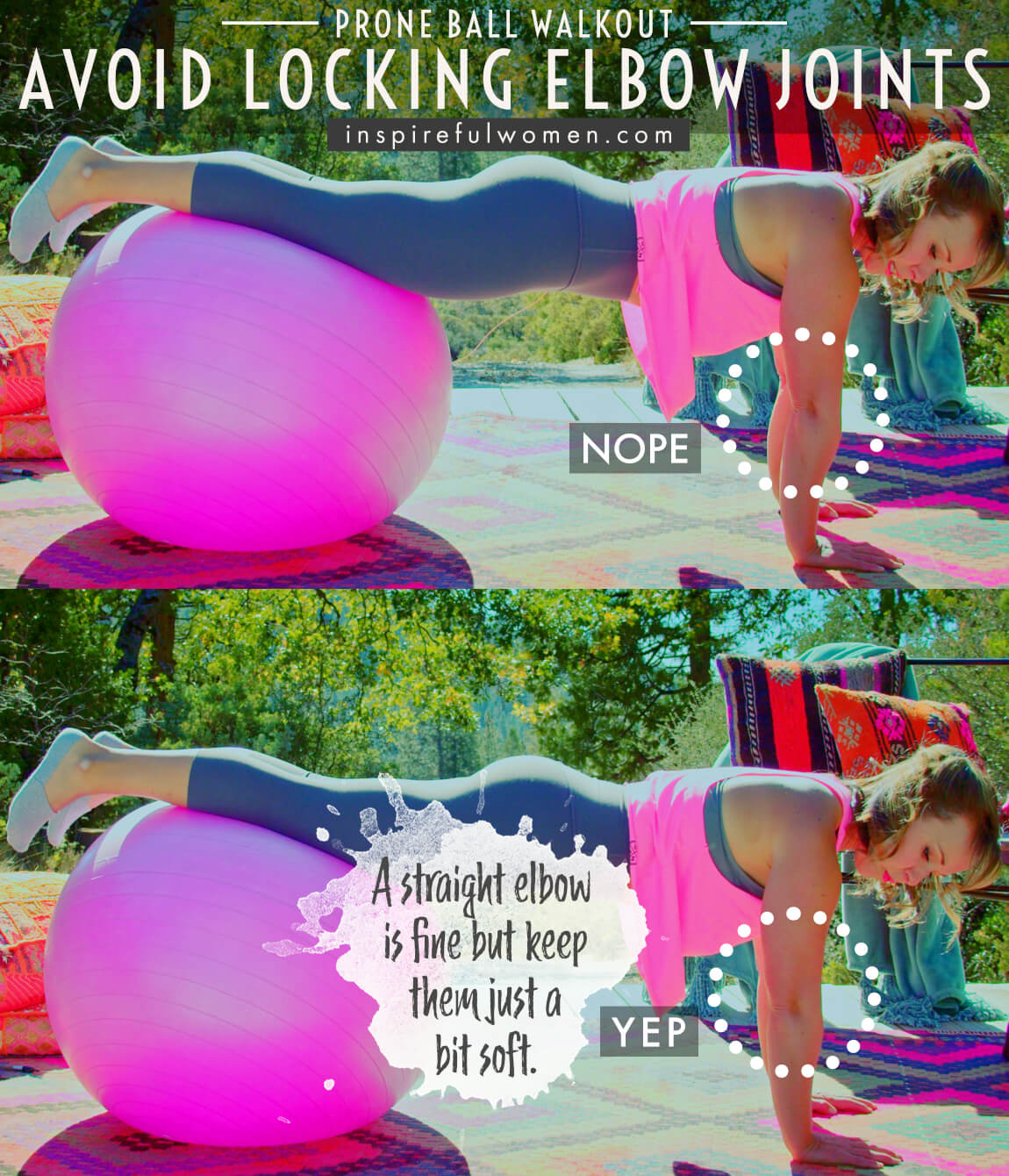
6. Avoid Dropping Into Shoulder Joints
AVOID: Avoid dropping into the shoulder.
WHY NOT?
- Stresses the shoulder joints, and increases the lumbar curve.
WHAT TO DO:
- Keep the shoulders back and sternum lifted.
- Press down into the floor with the support hand.
- Lengthen the spine (includes neck) and energize the arm that is reaching out.
- This will activate the muscles of the core.
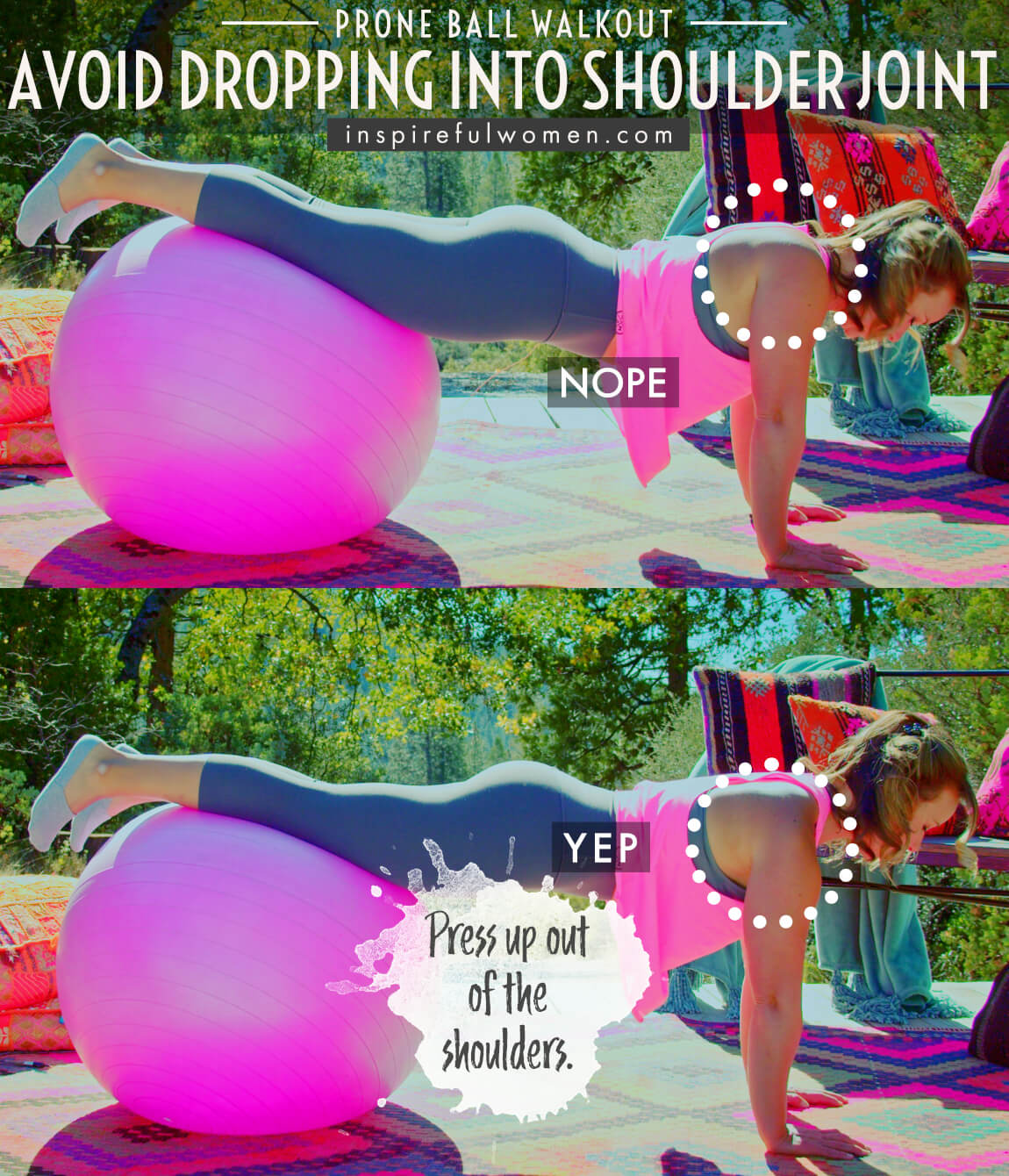
SCIENCY STUFF
SCIENCY STUFF
SPIFFILICIOUS FACTS ABOUT MUSCLES & MOVES
All of the muscles of the core work together to stabilize the spine. The muscles include the erector spinae and back extensors: (semispinalis, multifidi, rotatores, interspinales and intertransversarii) which can extend (bend backward) the spine, or control or prevent spinal flexion (bending forward); The quadratus lumborum muscle can side bend the spine, or prevent or control side-bending, The internal and external obliques can flex and rotate the spine, or prevent or control rotation and extension of the spine. The rectus abdominis flexes the spine and controls or prevents spinal extension. The transverse abdominis muscle is the deepest abdominal muscle, it wraps around the entire abdomen in the transverse plane (horizontally) like a corset. The function of the transverse abdominis is to compress and stabilize the abdomen.
The muscles of the back and abdomen work at low levels intermittently when standing upright. They become more active when the body is no longer vertical, and gravity pulls the torso into flexion, side-bending, or extension.
The main function of the muscles of the torso is to protect the spine from excessive movement. Too much movement in the spine can lead to injury or damage to the joints of the spine or the nerves that exit between the vertebrae. These muscles work any time we are in an upright position: standing, sitting, running, walking. The muscles become more active when on an unstable surface - like a ball, and when we are moving the arms or legs.
ALLLL MUSCLES & WHEN
ALL MUSCLES WORKING & WHEN DURING THE Prone Stability Ball Walkout
In the beginning position, the muscles of the torso are fairly quiet because the torso is resting on the ball. The quadriceps act concentrically to push off the floor to move the body forward.
The hands contact the floor and begin walking the body forward. The arm and shoulder blade muscles (deltoids, biceps, triceps, teres major, muscles of the forearm, scapular muscles, rotator cuff muscles latissimus dorsi) work together to stabilize the shoulder blade and move the body forward. When the torso passes the ball the muscles of the core - extensor spinae, deep spinal extensors (semispinalis, multifidi, rotatores, interspinales and intertransversarii), quadratus lumborum, obliques, rectus abdominis, and transverse abdominis all contribute to holding the spine in neutral. Pelvic floor can help if you work on activating it.
The hip muscles work to hold the pelvis level: iliopsoas, adductors magnus, brevis, and longus, gracilis, gluteus maximus,medius, and minimus, hamstrings, and the quadriceps femoris. Other muscles (deep hip stabilizers, sartorius, lower leg muscles) may help if you are able to walk out so that only the lower leg/feet are on the ball (the more you need to work to hold yourself still the more muscles will be recruited).
Once you have walked out as far as you are able while maintaining control - all of the core muscles, the shoulder, arm, and hip stabilizers work isometrically to hold the body still.
PIN IT FOR LATER!
